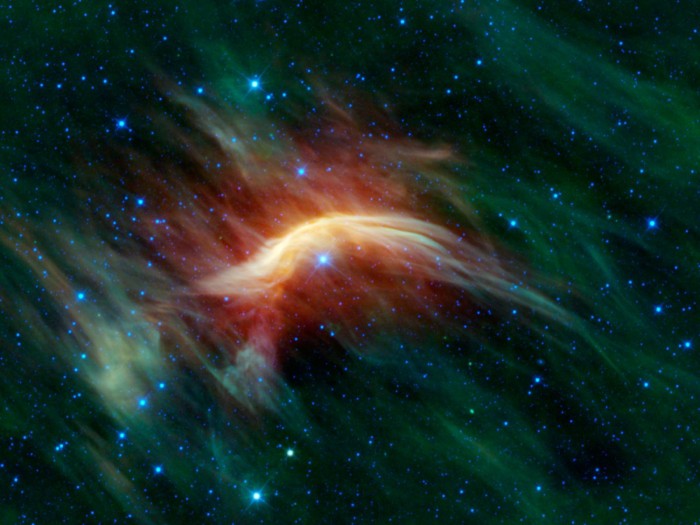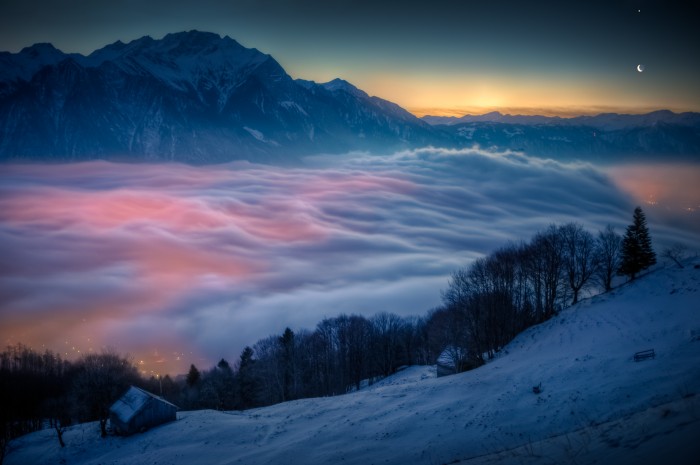ESO ALMA Antenna Time Lapse
What a dazzling time-lapse display of the Milky Way as seen from Chile at night:
Time-lapse of a whole night at the ALMA Array Operations Site (AOS), located at 5000 meters altitude on the Chajnantor plateau, in the II Region of Chile. As the Moon sets at the beginning of the night, three of the first ALMA antennas start tests as part of the ongoing Commissioning and Science Verification process. Because they are pointing at the same target in the sky at any moment, their movements are perfectly synchronized.
As the sky appears to rotate clockwise around the south celestial pole (roughly on the upper left edge of the video), the Milky Way goes down slowly, until it is lying almost horizontal before sunrise. The center of our galaxy becomes visible during the second half of the night as a yellowish bulge crossed by dark lanes in the center of the image, just above the antennas.
The flashes on the ground are the car lights of the guards patrolling at the AOS. ALMA, the Atacama Large Millimeter/submillimeter Array is the largest astronomical project in existence and is a truly global partnership between the scientific communities of East Asia, Europe and North America with Chile. ESO is the European partner in ALMA.
Source: ESO
STS-130 Shuttle Launch
Nothing to see here… Just a really awesome-looking shuttle launch (STS-130):
The Runaway Star Zeta Ophiuchi
Zeta Ophiuchi is a star 20 times as massive as the sun that was blasted away by a supernova and now ravages the stellar sky at a speed of 24 kilometers per second. Insane!
From NASA WISE:The blue star near the center of this image is Zeta Ophiuchi. When seen in visible light it appears as a relatively dim red star surrounded by other dim stars and no dust. However, in this infrared image taken with NASA’s Wide-field Infrared Survey Explorer, or WISE, a completely different view emerges. Zeta Ophiuchi is actually a very massive, hot, bright blue star plowing its way through a large cloud of interstellar dust and gas.
Astronomers theorize that this stellar juggernaut was likely once part of a binary star system with an even more massive partner. It’s believed that when the partner exploded as a supernova, blasting away most of its mass, Zeta Ophiuchi was suddenly freed from its partner’s pull and shot away like a bullet moving 24 kilometers per second (54,000 miles per hour). Zeta Ophiuchi is about 20 times more massive and 65,000 times more luminous than the sun. If it weren’t surrounded by so much dust, it would be one of the brightest stars in the sky and appear blue to the eye. Like all stars with this kind of extreme mass and power, it subscribes to the ‘live fast, die young’ motto. It’s already about halfway through its very short 8-million-year lifespan. In comparison, the sun is roughly halfway through its 10-billion-year lifespan. While the sun will eventually become a quiet white dwarf, Zeta Ophiuchi, like its ex-partner, will ultimately die in a massive explosion called a supernova.
What's Waiting in Lake Vostok?
It’s that time of year again — time to discover new forms of life. Russian scientists are quite near Lake Vostok, an underground lake that’s been isolated from the world since before there were humans.
From celsias:Lake Vostok has never encountered humans. Its been undisturbed for 15 million years, and is completely unknown. It’s a subglacial lake about 4,000 metres beneath the ice sheet in Antarctica. It is in Antarctica, at Vostok, which also has the world’s coldest reported temperature, so it’s not been easy to get at to say the least.
I wonder what kind of extremophile creatures might be waiting down there — bacteria and insects from “another planet”.
From Wikipedia:The lake is located beneath Russia’s Vostok Station, 4,000 metres (13,000 ft) under the surface of the central East Antarctic ice sheet. The ice surface is at 3,488 meters (11,444 ft) above sea level. The lake is 250 kilometres (160 mi) long by 50 kilometres (31 mi) wide at its widest point, thus similar in size to Lake Ontario, and is divided into two deep basins by a ridge. The water over the ridge is about 200 metres (660 ft), compared to roughly 400 metres (1,300 ft) deep in the northern basin and 800 metres (2,600 ft) deep in the southern. Lake Vostok covers an area of 15,690 square kilometres (6,060 sq mi). It has an estimated volume of 5,400 cubic kilometres (1,300 cu mi) and consists of fresh water. The average depth is 344 metres (1,129 ft).
Moon and Venus Over Switzerland
What a surreal capture of a of a clouded village in Switzerland with Venus hanging overhead:
Can’t believe it’s not manipulated.
From NASA APOD:
Sometimes a morning sky can be a combination of serene and surreal. Such a sky perhaps existed before sunrise this past Sunday as viewed from a snowy slope in eastern Switzerland. Quiet clouds blanket the above scene, lit from beneath by lights from the village of Trübbach. A snow covered mountain, Mittlerspitz, poses dramatically on the upper left, hovering over the small town of Balzers, Liechtenstein far below. Peaks from the Alps can be seen across the far right, just below the freshly rising Sun. Visible on the upper right are the crescent Moon and the bright planet Venus. Venus will remain in the morning sky all month, although it will likely not be found in such a photogenic setting.


